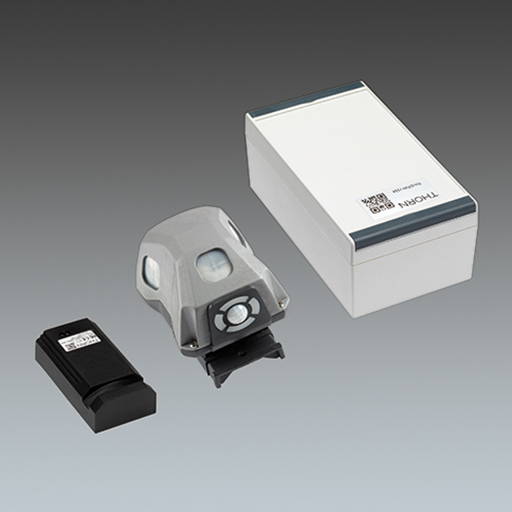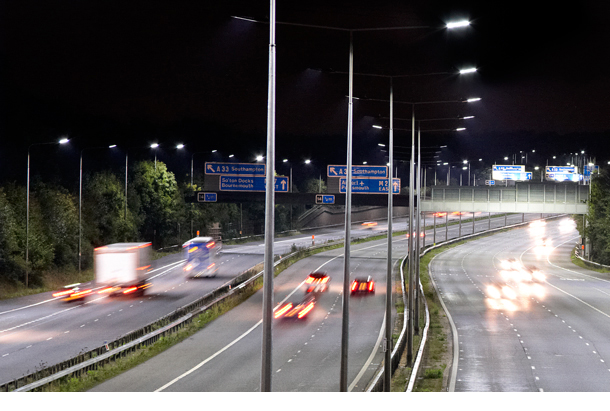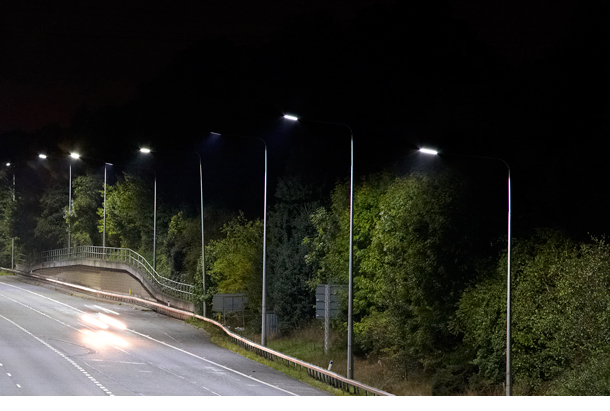TAG | LED fittings
Thorn launches a new scalable Radio Frequency Outdoor Lighting Controls solution.

In a bid to make outdoor lighting controls easier to understand and implement Thorn has released a simple portfolio for managing groups of luminaires or total city applications.
The new radio frequency (RF) based outdoor lighting controls system is designed to provide energy savings and remote data management for energy conscious cities and communities, offering complete application and cost flexibility with sensor-based and non-sensor based RF nodes.
One of the most innovative features includes the “moving light” functionality which programs the light to switch on and then trail cars, bicycles and pedestrians, guaranteeing that light is only activated when needed, reducing waste light and decreasing energy consumption.
To make life simpler and to be future ready RF OLC works on an open protocol to enable operation with other smart city functions and it has been designed with future proofed RF technology; ready for whatever lies ahead.
Visit www.novelenergylighting.com or call us at 0208-540-8287 to discuss your project needs and explore Thorn products
LED fittings · led lighting · lighting controls · Novel Energy Lighting · outdoor lighting · thorn led · thorn lighting · thorn olc · thorn rf
Ivan Perre is an electrical engineer for London Underground working within the integrated stations programme. Lux sat down with Perre to talk LED testing and plans for the future of the Underground.
We need to know how products will perform
I’m involved in a number of areas in lighting for Transport for London (TfL). While I’m an engineer by day, the majority of my work is in verification and testing of LED systems. I’ve researched in the field of photometry and how LED light is measured, and I have subsequently developed methods to more accurately determine LED lux levels. This means that we can have greater confidence in the products we specify but also have a better understanding of how they perform in the field.
We test products really carefully
Any new technology, such as LEDs, is under scrutiny and we have a responsibility to our customers to ensure there is sufficient light.
The optical filters used in lux meters are designed to replicate the responsiveness of the human eye. This is characterised by the spectral responsivity of the lux meter, which is a bell-shaped curve. By using some tracing software, I am able to trace out the graph and convert it into data, which I can then extrapolate to get the values for each wavelength.
Once this is done, I am able to simulate the given light and find out what the lux value would be, and then I can compare it to the ideal lux value.
This process ensures that we can collect accurate and important data, specify the right products for the job, but more importantly deliver a better service to our customers.
We’re thinking outside the tunnel
One of the challenges we face at the moment is implementing feature design more effectively. We are starting to change the way we think about the station environment and in the future, we want to use light in different ways to highlight certain areas, introduce contrasts and create different atmospheres.
This is especially important as we’re looking at potential retail opportunities down the line, which have a number of other prerequisites in terms of lighting designs and outcomes.
“In the future we want to use light in different ways to highlight certain areas, introduce contrasts and create different atmospheres”
The new Night Tube service is a maintenance challenge
The new Night Tube service is a maintenance challenge
One of the main priorities for TfL is to try to reduce maintenance. This is becoming more important with the Night Tube coming up, which is a round-the-clock service on Fridays and Saturdays on the Jubilee, Victoria, and most of the Central, Northern and Piccadilly lines.
This will significantly eat into our engineering hours, and we want to reduce the number of interventions required where lighting is concerned. The longevity of LED lighting is a big factor in assessing the suitability of new fittings, as they don’t need re-commissioning as often.
Stations need a consistent look and feel
One of the most important projects we’re undertaking at the moment is a series of substantial works across a number of stations to create an integrated look and feel between new and existing elements.
We’re working with Crossrail to assimilate the interface zones between services, so there is a consistent feel between the two and not a stark contrast when you leave one service and enter another.
Test schemes make a big difference
We’re lucky to have a number of successful test schemes at TfL to reflect on, which invariably inform new projects. A couple of years ago we implemented the first LED column lighting system on the underground at Wimbledon Park tube station, which was a turning point in upgrading lighting systems as it proved to deliver huge energy and maintenance savings.
Smart controls need to be smarter
One of the things we need at TfL is to be able to change the drivers once they’ve failed without the need to program them. We want the new drivers to operate within the current system as close as possible and when they don’t it’s an issue. When there is only a short hour shift, it’s difficult to go around re-commissioning fittings if there’s a lot to do.
We’re very keen on controls and there are a number of benefits including maintenance, energy and functionality. With a new design idiom being developed for TfL, controls will become an imperative as we’ll need to control individual lights to provide different levels and different intensities.
We’re harnessing the power of procurement
I’m also involved in procurement of lighting technology and innovation in Europe through the Pro-Lite project. The project allows public sector authorities across Europe to team up and pool resources. That way it’s easier to procure innovative technology and consolidate our procurement power to create economies of scale.
The idea is to set technical standards and specifications to create opportunities for improved lighting solutions throughout member states. We have recently released the technical specifications that we’re going to use to go out for tender and we’re also in the process of finalising a whole-life cost model, so we can make like-for-like comparisons of light fittings.
I’m excited about new lighting technologies
I like the idea of using organic LEDs (OLEDs) although I’m not sure how we’d be able to use them in our material compliance. I also like the look of remote phosphor as it sounds like it’ll be a big step up in terms of efficiency.
Visit our main website today to explore LED lighting technologies for your retrofit project.
LED fittings · led fixtures · LED lamps · led lighting · led underground · london underground · lux · Novel Energy Lighting · subway lighting
30
GE reshuffles brass to stir up lighting innovation
Comments off · Posted by admin in LED, LED downlights, LED GU10, LED panels, LED Spots

Reconvergence: Beth Comstock has helped guide industry convergence before, when she ran digital media for NBC Universal and the Googles were infiltrating traditional film and broadcasting. She’ll try it again at GE as the lighting industry goes Net.
LUX Magazine reports: When you’re an aging corporate conglomerate and you’re trying to decide how your lighting division can survive in the digital era, do you a) get rid of it, or b) try to infuse it with an innovative spirit?
For Philips and Siemens the answer has veered toward ‘a,’ most recently with Philips’ announcement this week that it will seek ‘alternative ownership’ for its lighting group, a move that echoes Siemens’ 2013 spin-off of its Osram lighting company.
At GE however they’re taking a new crack at ‘b’ with a quiet corporate restructuring in which CEO Jeff Immelt has fused GE Lighting with a division charged with ‘growth and innovation’ and whose boss, Beth Comstock, also runs the Silicon Valley-based GE Ventures, a firm that invests in startups in software, energy, healthcare and manufacturing.
‘On Monday, Sept. 16 GE announced internally that they will align the Lighting business with GE’s growth and innovation team, led by Beth Comstock,’ GE told Lux in an email. ‘The transition is not effective immediately. It will happen over the next few months.’ The company has yet to publicly announce the change. The move had surfaced in an article in Fortune Magazine, which said Comstock takes the lighting reins on Oct. 1.
‘NOT FOR SALE’
It was Comstock who two weeks ago told Lux that GE Lighting is not for sale, denying rumours that if true would put U.S.-based GE in the same category as Holland’s Philips and Germany’s Siemens as traditional large industrial companies moving away from direct involvement in the lighting industry.
As part of the shift, Maryrose Sylvester continues as president and CEO of GE Lighting, but she will report to Comstock. Sylvester had been reporting to Chip Blankenship, who has been president and CEO of GE’s appliance and lighting business unit. Earlier this month GE sold its appliance division – dishwashers, toasters, washing machines and the like – to Sweden’s AB Electrolux for $3.3 billion.
Appliances and lighting had accounted for $8.3 billion in sales at the $146 billion company last year. Lighting was about $3 billion of that GE told Lux this week – until now, GE has not separated out lighting numbers from appliances. Appliances was the latest division to go at GE as the company focuses on high margin industrial goods and services.
Comstock, a rising star at GE who also serves as corporate marketing officer and senior vice president, reports directly to Immelt.
BEEN THERE DONE THAT
She has solid experience at the type of digital industry convergence that challenges today’s lighting business, which is shifting from conventional incandescent and fluorescent bulbs, to lights based on LEDs – light emitting diodes, or semiconductors – a transition that is opening up the field to new digital only manufacturers and to Internet and consumer technology companies like Google and Apple.
Her background includes several years overseeing digital strategy for media giant NBC Universal as president of integrated media, when broadcasting giants like NBC, CBS and ABC were beginning to cope with the incursion of technology powerhouses like Google and YouTube into their industry (NBC was part of the GE empire at the time; GE sold its remaining 49 percent share to cable TV company Comcast for $16.7 billion in early 2013).
That familiarity could help Comstock navigate GE Lighting around a global market where lighting could underpin everything from smart cities to the connected home, and which will rely on innovations and partnerships with technology and networking firms among others.
All the while, she will have to figure out a way to make money. LED bulbs cost much more to make than conventional bulbs, but startup companies are pushing down end user prices faster than some of the cost-burdened giants can afford. LEDs in principle also last much longer, eradicating any replacement bulb business model.
Thus, GE will have to hone a profitable business out of selling lighting services, controls and connectivity.
NETWORKING
Not only will it have to foster relationships with Internet and networking companies, but it will have to fend off challenges from relatively new lighting companies like Opple, Cree, TCP and Acuity, born in the modern lighting era and not encumbered by a legacy lighting business (GE and Philips have both been a making bulbs for over 120 years).
No wonder, with challenges like this, Philips decided on an ‘alternative ownership’ escape route. Even after an impressive run of innovations that has included the Hue line of bulbs that can change brightness and colours via wireless remote control, Philips is setting into slow motion a plan to find buyers for its lighting division, which it says could take a year or two. (Some industry observers are even whispering about a hookup between Philips and GE. Neither company would comment on that speculation).
Comstock told Fortune that there’s tremendous opportunity to partner with startups that develop LED technology for commercial and government buildings.
She certainly talks the talk.
‘Beth Comstock is passionate about change and innovation,’ reads her bio on GE’s corporate website, not yet updated to relfect her new lighting role. ‘She leads GE’s growth efforts via marketing, sales, licensing and communications and oversees GE Ventures. Her current priorities include partnering with and investing in start-ups, developing new markets in analytics, energy and affordable health through GE’s industrial internet, ecomagination and healthymagination initiatives, and making connections that spur a culture of inventiveness and grow brand value.’
It also notes that she serves on the boards of Nike and of Quirky, ‘an online hub that makes invention accessible.’ Quirky helped GE develop its Link connected bulb.
Looks good on paper. Let the innovations begin. There aren’t many other choices.
Shuttla
beth comstock · energy efficient lighting · energy-efficient buildings · ge lighting · LED fittings · LED lamps · led lighting · led tubes · Novel Energy Lighting · smart lighting
LUX Magazine Jun-2014 reports:
On the ROAD
How new lights on the M3 will not only save energy and maintenance but could also save lives
LUX magazine reported that if it had been taken a short time earlier, the photo to the right would have looked distinctly more orange. It shows part of the M3, which stretches from southwest London to Southampton, which has been fitted with new LED luminaires that provide clear white light and replace high-pressure sodium (SON) light sources.
Saving energy was the main motivation behind the change, and the 250 and 150W SON fittings were found to be the main culprit in energy consumption. EM Highway Services, which operates and maintains this part of the M3 on behalf of the Highways Agency, was asked to find more energy-efficient lighting.
EM opted for an upgrade to Philips’ Luma 3 LED fittings, and a total of 476 luminaires were installed along the motorway. The brief was to create uniform light distribution across the lanes, but it was also important that the LED configurations were flexible because the M3 sometimes operates with a 10-lane arrangement with varying light levels. The new luminaires are modular and can be combined with a number of different optics, making the fitting ideal for the job.
As well as saving energy, the white LED light has improved visibility on the motorway. This might save lives in dangerous situations; drivers can detect movement faster and at a greater distance, giving them more time to stop if they need to. As an added bonus, the brighter light makes it possible to reduce light output without compromising light quality, saving even more energy.
Julian Nassar, electrical stream project engineer from EM Highway Services says: ‘By using the Luma LED technology, we have been able to provide high-quality, reliable lighting using less energy while also saving on maintenance costs. This has provided increased safety for the road user through an improved light source.’
Novel Energy Lighting sells top quality LED lamps, bulbs and tubes at the lowest trade, retail and wholesale prices. We are able to supply the full range of Philips trade and specification LED products including the Luma 3 LED road fittings. Contact us for your project. Most of our LED products have up to 5 years warranty and 30 days satisfaction guaranteed. These lights offer lifetime cost benefits with up to 90% energy savings and up to 50,000 hours of operational lighting. LED Lighting is recommended for cost efficiency and energy savings.
LED · LED fittings · LED lamps · LED lights




